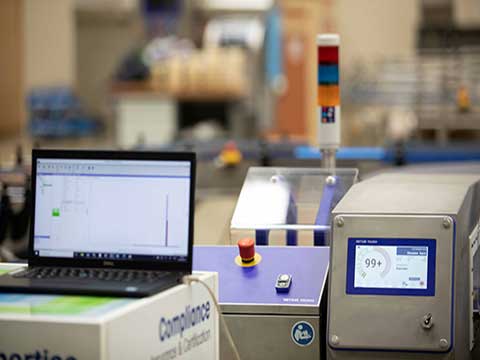
Posted to News on 3rd Apr 2024, 11:09
The strategic value of food safety digital maturity
As the food supply chain undergoes modernisation and calls for heightened transparency in food safety grow louder, food manufacturers find themselves facing the need to embrace digitalisation. According to Ian Scott-Mance, technology manager at Mettler-Toledo Product Inspection, rather than viewing this as a challenge, they should perceive it as a strategic opportunity to unlock significant value for their businesses.

For food manufacturers worldwide, the unwavering priority is clear: food safety is non-negotiable. Protecting consumers from microbiological and physical contaminants necessitates a meticulous approach from every player in the industry. As the landscape evolves, so do the demands of stakeholders, ranging from governments and industry organisations to retailers and supermarkets.
Stakeholders are increasingly formalising their expectations into frameworks that food manufacturers must adhere to, paving the way for a new era of digital integration. While current regulations do not mandate digital records, initiatives like the US Food and Drug Administration's (FDA's) New Era of Smarter Food Safety and Global Food Safety Initiative's (GFSI's) Race to the Top underscore the gathering momentum for digital food traceability.
Think of the farmer weighing and recording batches of potatoes, or the food manufacturer inspecting for contaminants with electronic data records, or a logistics partner maintaining prescribed temperatures with instant access to historical data. This digitalized future enhances efficiency, compliance and product recall capabilities. These examples show the future is clear: the entire food supply chain will inevitably embrace digitalised food safety processes to meet evolving requirements. So, what do manufacturers need to do? Embrace it quickly to be a step ahead.
Unlocking efficiency through digitalisation
Digital record-keeping, automatically collected and easily shared, is set to become commonplace, revolutionising efficiency, compliance and traceability. The data generated will empower food manufacturers to operate more efficiently, comply with auditor requirements seamlessly, and significantly reduce the time and resources needed in the event of a product recall. The future promises more targeted and speedy product recalls.
However, the current state of digital technology implementation in the industry is fragmented. Each company, amidst this complexity, must embark on a journey toward achieving a degree of digital maturity around their food safety processes.
The term towards' is crucial here. Given the vastness and complexity of the food manufacturing industry, not every link in the chain will reach the most sophisticated standards of digital maturity. The imperative for a farmer and a multinational food producer will differ, but both can contribute to a supply chain based on digital data and transparency.
Navigating compliance and business imperatives
The journey towards food safety digital maturity is one that hinges on compliance and business imperatives, necessitating a careful balance where the value derived surpasses the associated costs.
Currently, global regulations lack specificity, leading to a varied landscape where different countries enact isolated initiatives. For instance, the FDA in the US outlines rules for data records compliance, with exceptions based on company size and cost absorption capabilities. This lack of a universal mandate places companies, theoretically, at Level 1 of the digital maturity pyramid.
This brings us to an interesting topic: the pyramid. What exactly is it and where do businesses sit within it? Ascending the pyramid reveals businesses with progressively enhanced digital capabilities. At Level 2, companies manually collect digital data from machinery, often using USB sticks. Level 3 is where data collection is automated supporting auditing, reporting and production efficiency improvement.
Further levels of digital maturity, more relevant to larger enterprises, envision deeper integration of food safety data with customer and cloud applications, driven by internal operational excellence programs.
In light of this diversity, each participant in the food supply chain must understand its current digital maturity status in terms of food safety processes. The focus should then shift to analysing how the collection and sharing of digital data can not only benefit the entity itself but also contribute to the broader ecosystem of supply chain partners.
Anticipating the inevitability of digital maturity as a future necessity, companies must proactively lay the groundwork for the digital capabilities essential for their roles in a digitally enabled food supply chain, emphasising food safety best practices and governance.
Digital maturity in food safety
As digital technology continues to advance, industries across the board have reaped the rewards of enhanced efficiency, accelerated time-to-market and improved product quality and safety. The food manufacturing sector is no exception, as it faces the dual challenge of meeting regulatory compliance and consumer expectations.
The value of food safety digital maturity for manufacturers includes a number of advantages that are both quantifiable and, perhaps less immediately apparent, intangible. Check out the Quantifiable Value of Food Safety Digital Maturity':
Reduced production costs (estimated possible saving: 5%): Digital systems continuously monitor various production facets, enabling quick identification and rectification of negative performance trends. This proactive approach minimises issues like product giveaway and unplanned downtime.
Reduced time to access production critical data (estimated possible saving: 15%): Automated data collection and continuous monitoring expedite access to crucial production data. This immediacy aids in issue resolution, reduces reporting times and promotes a more productive and safer use of staff resources.
Reduced costs for managing products with quality Issues estimated possible saving: 11%): Digital systems provide automated, paperless documentation of rejected products, facilitating compliance and reducing re-work when potential food safety hazards are identified promptly.
Reduced audit and compliance management costs (estimated possible saving: personnel costs: 35%, in fines up to 100%): Continuous monitoring by digital systems leads to compliance-related data capture, streamlining the preparation of audit reports and minimising errors. This results in significant personnel cost savings and reduces the risk of fines.
The full calculations behind these examples can be found in Annex A, Mettler-Toledo Food Safety Digital Maturity Whitepaper.
While quantifiable benefits directly impact the bottom line, the digitalization of food safety processes brings additional advantages that are equally vital, but harder to measure. These include:
Complete traceability and timely recalls: Digital maturity enables comprehensive traceability, leading to quick and targeted product recalls. This not only reduces costs and wasted resources but also protects brand reputation and supply chain relationships.
Confidence in product quality: Continuous monitoring through digital technology instils confidence in product quality, providing instant insights into overall operational performance. Operations and Quality Assurance managers can make more informed and timely decisions, contributing to enhanced product quality.
A collective journey
For food manufacturers and supply chain partners, achieving digital maturity requires a collaborative endeavour. The journey holds various stages, each illustrating how data can be collected and leveraged within the food supply chain.
In the field during the picking stage, for example, digital records encompass soil treatment details, geo-data systems and weighing systems, thereby enriching traceability and transparency. Moving to logistics and warehouse operations, particularly in dispatch and receiving, digital records cover transport specifics, testing procedure and quality control processes, offering a streamlined approach to compliance and traceability.
Within processing plants undergoing multiple transformations, digital records encompass the origin, processing and testing procedures, offering transparency, traceability and better compliance. In packaging and quality control, digital records are pivotal, capturing processes related to packaging and product inspection, contributing significantly to traceability and transparency.
As products proceed through logistics and warehousing in the dispatch phase, streamlined digital documentation, product verification and digital records of transport collectively offer robust traceability. Finally, at the retail stage during receiving and selling, a comprehensive digital view of supply chain compliance, covering product verification and storage, fosters traceability and compliance support.
Three fundamental steps
While there's no one-size-fits-all blueprint, organisations can consider common steps: audit existing food safety data, develop a strategic plan for transitioning from analogue to digital, address expertise gaps and implement continuous testing programs to drive cultural change hand-in-hand with technological advancement.
The journey toward food safety digital maturity may appear formidable, but its essence lies in simplicity, encapsulated in three fundamental steps:
1. Connect your devices
2. Collect food safety relevant data
3. Use data to optimise processes, networks and supply chain relationships
What is clear is the escalating importance of enhancing the digital maturity of food safety processes. While an immediate legal mandate for a digital food supply chain remains absent, the evolving landscape underscores the growing demand for transparency in the supply of safe, high-quality food. Governments, industry bodies, partners and consumers are increasingly advocating for greater visibility, and digital transformation is the pragmatic means to achieve transparency and meet heightened compliance requirements.
This brings us to the pivotal question of what comes next. How can food companies progress toward food safety digital maturity, and what hurdles will they confront? First and foremost, manufacturers must act quickly the need for digitalisation is growing every day. Importantly, though, this journey need not be undertaken in isolation. Collaborating with technology and network infrastructure partners can help navigate complexity, identify optimal starting points, and chart smooth pathways forward. Embracing such partnerships and leveraging the expertise available in the marketplace is crucial.
While food safety remains imperative, digital maturity is not an immediate mandate. However, it is an impending reality. The earlier businesses embark on the journey to food safety digital maturity, the sooner they will reap the multifaceted benefits it brings to their business.
With perseverance, strategic planning and the right partners, every company in the food sector can anticipate a successful transformation of its digital capabilities concerning food safety. This transformation positions each entity to play a pivotal role in shaping tomorrow's fully transparent and digitally mature food industry. As we envision this future, the collaborative efforts of stakeholders will undoubtedly lead to a more resilient, efficient and secure food supply chain.






